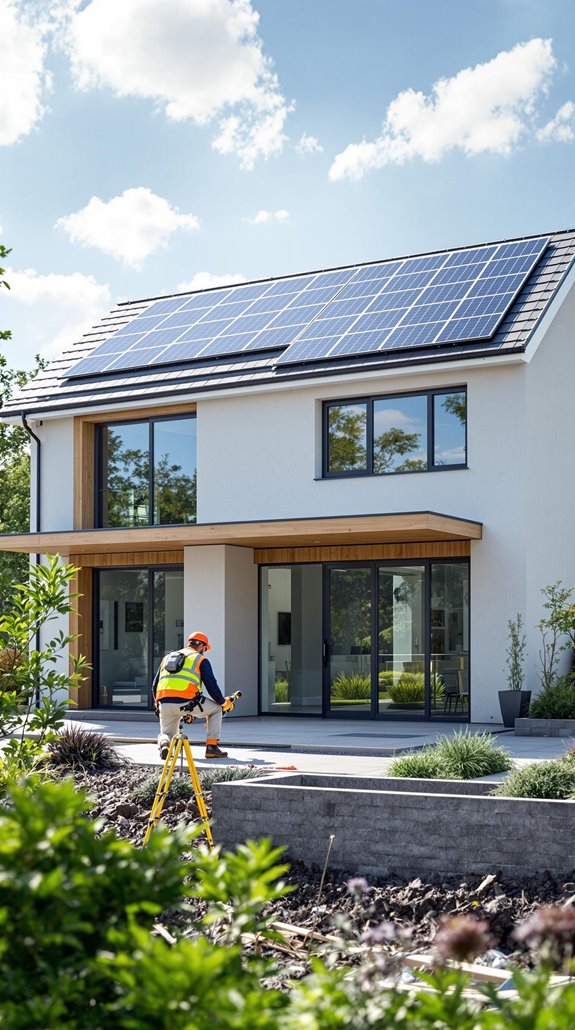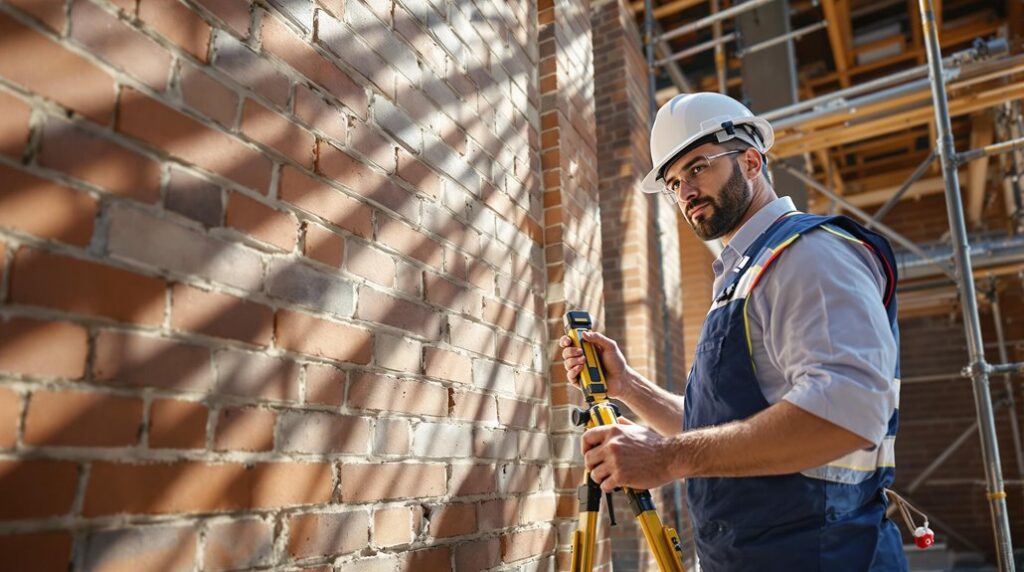I’ve surveyed hundreds of new build properties across the UK, and I can’t stress enough how critical a thorough survey is before you commit to purchase. The 2025 Future Homes Standard isn’t just regulatory paperwork—it’s basically changing how these properties are constructed, from mandatory heat pump installations to specific building fabric requirements. Without proper verification of compliance through SAP testing and certification checks, you’re practically buying blind into what could become an unsellable asset.
Key Takeaways
- Verify SAP calculations and energy assessments are completed – properties cannot be legally occupied without proper documentation from Building Control.
- Confirm triple glazing meets U-value requirements of 1.2 W/m²K or lower for Future Homes Standard compliance by 2025.
- Check airtightness test results and thermal bridging calculations to ensure the building fabric meets mandatory insulation performance standards.
- Ensure MVHR ventilation system is properly commissioned and verified by surveyor for Part L compliance in airtight homes.
- Request copies of all compliance documentation including SAP reports, as assessment costs range from £300-£600 based on building size.
Future Homes Standard: What Every New Build Must Meet by 2025

When the Future Homes Standard becomes mandatory in 2025, every new build in the UK must achieve a 75-80% reduction in carbon emissions compared to current building regulations. I’ll break down what you need to verify when surveying properties.
First, check the building fabric specifications. You’re looking for high-quality insulation, enhanced airtightness measures, and triple glazing throughout. The windows must meet U-value requirements of 1.2 W/m²K or lower – anything higher won’t comply. Additionally, this shift towards sustainability aligns with anticipated trends in the UK housing market that emphasize eco-friendly practices.
Next, examine the heating system. Gas boilers won’t cut it anymore. You’ll find heat pumps or other low-carbon alternatives instead. These systems work alongside improved ventilation standards under updated Part F regulations. Properties built after June 2022 should already meet more rigorous requirements that serve as stepping stones toward full FHS compliance.
Heat Pumps and Low-Carbon Systems: Why Gas Boilers Are Banned
Gas boilers face a complete phase-out in new UK builds from 2025, but the government’s scrapped plans for a total 2035 ban create confusion around what’s actually prohibited.
I’ll break down what you need to know: new builds can’t install gas boilers after 2025, but existing homes aren’t affected. You’ll see heat pumps become the primary heating solution—air source and ground source variants dominate specifications. Electric boilers powered by renewable energy offer another compliant option. Incorporating renewable energy sources is essential for achieving net zero carbon emissions.
Here’s the critical insight: hydrogen-ready boilers remain permitted, creating a potential loophole. The Future Homes Standard mandates 75-80% lower carbon emissions than current building regulations. When surveying new builds, verify the heating system meets these requirements. Don’t assume compliance—demand documentation proving the installed system satisfies low-carbon standards. Traditional heating methods currently account for one-third of UK carbon emissions, making this transition essential for meeting climate targets.
Building Fabric Requirements: Triple Glazing and Insulation Standards
Although the Future Homes Standard‘s heating system changes grab headlines, the building fabric requirements will transform how UK homes actually perform. I’m seeing mandatory triple glazing with U-values ≤1.2 W/m²K replacing double-glazed units across all new builds by 2025.
Wall insulation requirements drop from 2.8 W/m²K to 1.8 W/m²K under FEES, while roof standards tighten to 1.4 W/m²K. You’ll need photographic evidence for Building Regulations England Part L assessments – documentation that proves compliance. Regular communication with your solicitor is vital to ensure timely progress in your property transactions.
Air tightness testing becomes critical for envelope sealing, targeting 20-30% energy consumption reductions. Door U-values must hit 1.4 W/m²K, and thermal bridging minimization is mandatory at glazing junctions. Renewable energy sources are now a fundamental focus alongside energy-efficient materials under the updated Part L requirements.
These fabric improvements aren’t optional extras – they’re fundamental compliance requirements that’ll determine your home’s long-term performance and running costs.
Ventilation Compliance: MVHR Systems and Air Quality Regulations
Enhanced building fabric standards create hermetically sealed homes that demand sophisticated ventilation systems to maintain livable indoor conditions. I’ll guide you through the critical ventilation compliance requirements you must verify before purchasing.
MVHR systems aren’t optional—they’re essential for Part L compliance in airtight construction. These systems recover up to 90% of heat from extracted air while supplying continuous filtered airflow. You’re protecting your family from mould, condensation, and indoor pollutants that plague poorly ventilated homes. The Future Homes Standard mandates MVHR systems in new builds from 2025, making these installations a regulatory requirement rather than an optional upgrade. Furthermore, the integration of Passivhaus design principles in these homes emphasizes the need for effective ventilation solutions to achieve optimal energy efficiency.
Verify your surveyor confirms proper MVHR commissioning and integration with building fabric. Under SAP 11’s stricter calculations, mechanical ventilation becomes mandatory for meeting Dwelling Emission Rate targets. Don’t accept intermittent extraction fans—demand continuous mechanical systems that meet Approved Document F standards for ideal indoor air quality.
Certification Verification: SAP Testing and EPC Requirements You Need
Since Building Control won’t issue occupancy certificates without proper energy assessments, you must verify that your new home includes both design-stage and as-built SAP calculations. I’ll walk you through the essential documentation you need to secure.
Your surveyor should confirm the developer completed initial SAP calculations during the design phase using construction drawings, material specifications, and U-value evidence. The final as-built assessment must account for actual construction deviations, generating your official EPC rating. Additionally, understanding the cost implications of compliance can help you anticipate potential expenses related to your energy assessments.
Request copies of both SAP reports, thermal bridging calculations, and airtightness test results. These documents prove Part L1 compliance and determine your home’s energy efficiency rating. Assessment costs typically range from £300 to £600 depending on building size, so this expense should already be factored into the developer’s compliance budget. Without proper SAP verification, you’re buying a property that legally can’t be occupied. Don’t accept verbal assurances—demand documentary proof of energy performance compliance.
Conclusion
I can’t stress enough—commission that new build survey before you sign anything. You’ll need verified SAP calculations, confirmed MVHR installation specs, and actual U-value measurements for building fabric compliance. Don’t trust developer certificates alone; get independent verification of heat pump integration and thermal bridging assessments. Without proper testing documentation, you’re buying blind into 2025’s Future Homes Standard requirements. That survey fee protects your entire investment from costly retrofitting nightmares.
References
- https://www.cbre.co.uk/insights/articles/what-is-the-2025-future-homes-standard-and-how-will-it-impact-residential-real-estate
- https://www.norrsken.co.uk/newsitem/future-homes-standard-guide
- https://www.cuin.glass/blog/future-homes-standard/
- https://www.lkabminerals.com/news/what-is-future-homes-standard/
- https://www.elmhurstenergy.co.uk/blog/2025/06/10/5-key-changes-expected-with-the-introduction-of-the-future-homes-standard/
- https://www.tunley-environmental.com/en/insights/uk-future-homes-standard-with-whole-life-cycle-assessment
- https://theoffsiteguide.com/articles/the-2025-future-homes-standard-explained
- https://heatable.co.uk/boiler-advice/gas-boiler-ban
- https://heatable.co.uk/boiler-advice/can-I-replace-my-gas-boiler-after-2025
- https://www.britishgas.co.uk/the-source/greener-living/gas-boilers-ban-2025.html

